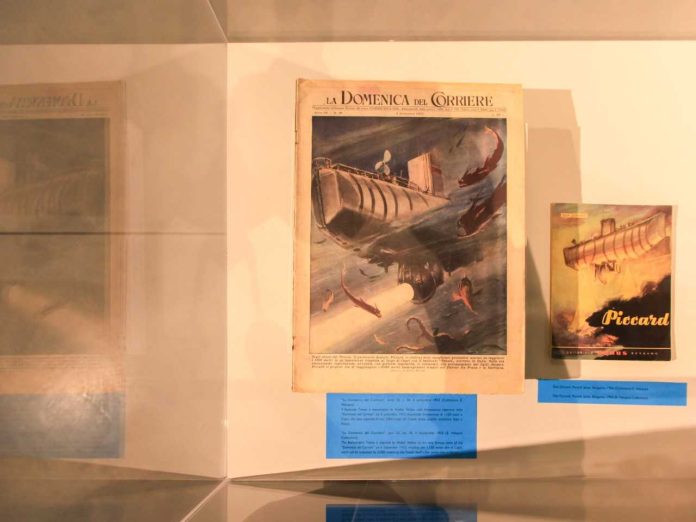by InTrieste
In a momentous ceremony, the Civic Museum for War and Peace, named after collector Diego de Henriquez, proudly opened the exhibition titled “The Trieste Bathyscaphe: Auguste Piccard’s Project, Diego’s Dream.” This showcase commemorates the 70th anniversary of the record-breaking dive of the bathyscaphe “Trieste” into the Tyrrhenian Trench near Ponza Island on September 30, 1953.
The exhibition, hosted at the venue on Via Cumano 22, Trieste, will run until March 3, accessible with admission to the de Henriquez Museum (Wednesday 10 am – 7 pm; Monday, Thursday, Friday, Saturday, Sunday 10 am – 5 pm; closed on Tuesday).
Notable figures attending the inauguration included Culture and Tourism Commissioner Giorgio Rossi, Council President Francesco Di Paola Panteca, Stefano Bianchi, the head of Historical and Artistic Museums for the City of Trieste, Antonella Cosenzi, the exhibition curator and museum director, Enrico Halupca, author of “Il Trieste,” and representatives of the Italian Navy.
Commissioner Rossi expressed pride, stating, “I am proud that this historic event, a milestone in human achievement, has its roots in Trieste. The municipal administration hopes that the de Henriquez Museum will become a major documentation center, showcasing Trieste and its nationally and internationally significant history. The relocation of the Natural History Museum to Warehouse 26 in the future will open up possibilities to realize this vision.”
On the 70th anniversary of the “Trieste” bathyscaphe’s record dive into the Tyrrhenian Trench near Ponza on September 30, 1953, the museum dedicated to Trieste collector Diego de Henriquez recounts a chapter of the extraordinary underwater vehicle’s history through Diego de Henriquez’s own memories. De Henriquez, a Trieste native (1909 – 1974), was the first in Italy to believe in the genius and project of Piccard, linking the city indissolubly to an event that has remained in the annals of planetary exploration.
The exhibition, located on the first floor in the Temporary Exhibition Hall of the Museum, features archival documents, bibliographic materials, photographs, and select items illustrating the close relationship formed in the early 1950s between Auguste Piccard (Basel 1884 – Lausanne 1962), his son Jacques (Brussels 1922 – Geneva 2008), and de Henriquez. The latter, enthusiastic about the Swiss professor’s project, actively supported it by leveraging his connections to secure backing from notable local and national entities for technical and financial support. Additionally, de Henriquez personally covered many expenses during the initial phases of constructing the submarine vessel.
The exhibition presents, for the first time to the public, original correspondence between Jacques Piccard and Diego de Henriquez, reconstructing the history of the Italian-Swiss bathyscaphe expedition, highlighting its scientific objectives and the visionary passion “for the Good of Humanity” that the collaborative project embodied, emerging in a world just emerging from the frightening tragedy of World War II.
Auguste Piccard’s 1955 document, “From the Stratosphere to the Ocean Depths,” begins with the significant words: “It was in the spring of 1952 that my son Jacques and I accepted the proposal from Trieste, initiated by Prof. Diego de Henriquez, director of the Historical Museum, to build a new bathyscaphe bearing the city’s name. We owe the successful completion of the first series of our experiments primarily to the Italian and Swiss generosity, which is why the flags of the two countries waved together on the Trieste.”
The hull of the “Trieste” was constructed in Monfalcone by the Adriatic Shipyard; the spherical cabin was forged in the Terni Steelworks; Navalmeccanica in Castellammare di Stabia assembled the various components, while the Italian Navy provided logistical support. In the years following 1953, piloted by Jacques Piccard, the bathyscaphe conducted several dives in the Gulf of Naples for scientific observations, involving specialized scientists and oceanographers. In 1960, under the ownership of the U.S. Navy, the upgraded bathyscaphe reached a depth of 10,914 meters in the Challenger Deep of the Mariana Trench, the Earth’s deepest point.
Today, the original vessel resides at the National Museum of the U.S. Navy in Washington, along with the spherical cabin forged in Terni in 1953, and not in Diego de Henriquez’s collections, as the Trieste scholar had initially hoped. Various reasons, including the challenging historical context in Trieste during those years, dashed the dream of displaying in the museum the two most significant peaceful exploration vehicles created by humans in the 20th century: the “Trieste” and a replica of the pressurized cabin with which Auguste Piccard, in 1932, became the first person in history to enter the stratosphere.
Curated by Antonella Cosenzi, the museum director, the exhibition is a collaboration with Enrico Halupca, the first to highlight Diego de Henriquez’s accounts in his book “Il Trieste” (Italo Svevo, Rome-Trieste, 2019), emphasizing the collector’s pivotal role, especially in the project’s early stages. Halupca has contributed literary material, select items, and an exclusive video created as an introduction to the exhibition.
Admission to the exhibition is included with the museum entrance ticket.
For information: Tel. 040 675 4699
museodehenriquez@comune.trieste.it





























